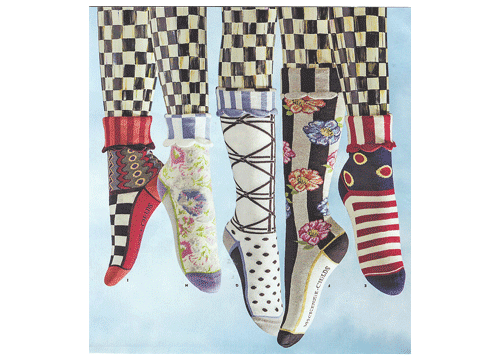
Do you find socks to be just an article of clothing, or do you really like socks? I have read that former president George Herbert Walker Bush loves socks and in every posted photo, he is wearing colorful socks. I am with George!
I love socks.
From the time Aunt Helen would take me back-to-school shopping for saddle shoes and white socks. I have thought very highly of socks. I imagine that Aunt Helen loved socks because she was always giving me socks! And I notice others who wear pretty or unusual socks.
I have socks for the Christmas season in reds and greens. I have socks for Valentine’s Day and St. Patrick’s Day and let us not forget Easter. I adore argyle anything, but especially argyle socks and Winter argyle sweaters. The sock drawer has a plethora of patriotic socks with stars and stripes and red, white and blue colors. Do not ask me how many pairs I have because the number exceeds three numerals. Yes, Virginia, that is correct. More than 100 pairs of socks.

The ancient Greek word sykchos gave way to the Latin soccus, the Old English socc which meant “light slipper” and the Middle English socke. Before nylon came into existence in 1938, socks were made of silk, leather, animal skin, linen, mohair, cotton, or wool.
The earliest known surviving pairs of socks were created by naalbinding around 300-500 A.D.. They were excavated from Oxyrhynchus on the Nile River in Eqypt. The toes were split to use with sandals. They are now on display at the Victoria and Albert Museum in London.
In ancient times the Greek poet Hesiod in the 8th Century noted that socks had been made from matted animal fur. The socks were called “piloi”. The first knitted socks were found in Jutland 1,500 years ago. The Reverend William Lee knitting loom began production in 1589. In the late 16th Century, machine-knit socks were first produced. Socks were a privilege of the rich as the manufacture of such was a guild secret.
One of the roles of socks is to absorb perspiration. The foot is one of the heaviest producers of sweat in the body. It can produce 0.25 U.S. pints of perspiration each day. In cold environments, socks that are made from wool help insulate the foot and offer protection from the ice and snow.
The township-level district of Datang in the Zhejiang Province, China, has become known as Sock City. It currently produces eight Billion pairs of socks yearly, which is a third of the world’s sock production. This production equates to two pairs of socks per person living today.
Have you ever lost a sock in the laundry? I have and the missing sock never shows up. Where do old and tired socks go exactly? Sometimes then I wear mis-matched socks! One brown argyle sock and one grey argyle sock and figure no one will notice! Hate to waste a good sock.
Socks can be a fashion statement. A businessman or woman might chose black socks to go with a suit or slacks. An athlete might wear tube socks to protect the legs from being scraped. In football, knee socks are used to stop grass burns. Crew socks can be worn with Oxfords, moccasins, and loafers.
Most of the year it is much better to wear both socks and shoes, isn’t it? Sandals, sans socks, are fine when Summer temperatures are warm. Flip-flops are suitable for the beach or backyard, but not proper etiquette for the office, the church, school, or the theatre.

